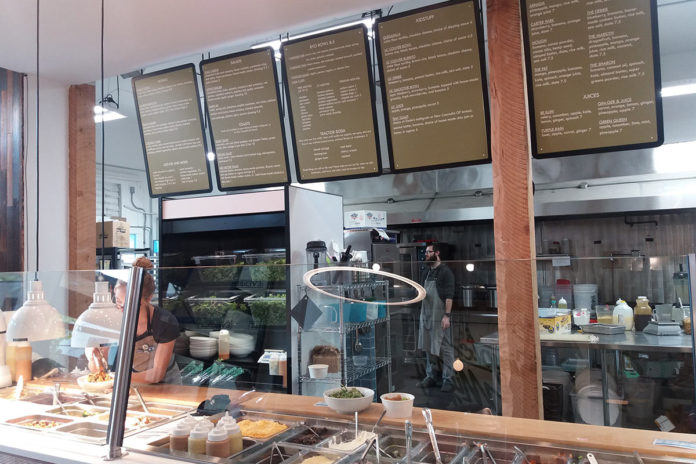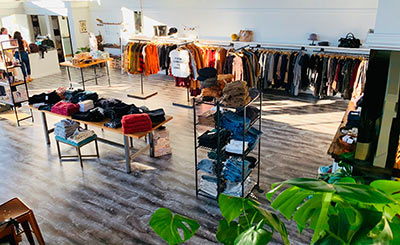
There has long been a divide – perceived and real – between Downtown Vancouver and Uptown Village. It appears that divide is growing larger because of the rapid development of the Vancouver Waterfront. Whereas the waterfront development seems to be lifting Downtown Vancouver out of a many-year slump, some say Uptown Village is seeing less foot traffic, which for retail and restaurant owners, means fewer customers. Combined with rising rents and new landlords moving into the area from outside the region, independent start-ups are feeling the pinch.
But, at least anecdotally, perceptions are mixed. When stalwart restaurateur Tommy Owens permanently closed his flagship downtown restaurant, Tommy O’s Pacific Rim Bistro, in December, he blamed – in part – the waterfront on his Facebook page, claiming it was decreasing his customer base and increasing the cost of doing business. Last spring, he had opened a second storefront in the Camas Hotel, the latest in a string of restaurants to occupy that space. In the past, Owens has also been a vocal opponent of food carts, claiming they would cut into the already sparse downtown food scene, but as recently as 2017, he told a local newspaper, “The demographic is growing enough, there’s a lot of people. Look at how many bars we have. There (are) so many new brew pubs. Business is good.”
Steve Valenta opened The Mighty Bowl food cart in Vancouver to great fanfare in 2012, and over the years, added carts and experimented with location and seasonality. At the time, the food cart laws demanded that carts had to keep moving, unlike in Portland where cart “pods” and single stationary carts have long been the norm. At the end of 2017, Valenta opened a permanent downtown restaurant, expanding on the cart’s core fare of simple healthy bowls. A smoothie and coffee counter was added in, as well as breakfast, all cozied up next to stadium style bleachers that overlook the daily bustle.
Valenta agrees that the density has increased downtown. More and more, regulars are on the bleachers at The Mighty Bowl but also, said Valenta, he sees people from out of town, traveling for work or pleasure, and coming from the Hilton, which continues to increase its convention schedule and send conference goers fanning into downtown for local far. As for the Vancouver Waterfront, he said, “I see it as all upside.” Valenta especially sees the waterfront as a model in designing development around bustling public space, which he says is lacking in Vancouver
“The city and the public need to focus on money and more energy and going into public space – parks, large pieces of artwork, open markets, any kind of interesting infrastructure that invites the public to gather,” he said. “People beget people.”
“We as citizens have to have an appetite for spending money on public spaces,” Valenta said. “I question the Vancouver community as a whole. I’m concerned we don’t have the appetite to spend money on these vital spaces.”
Overall, said Valenta, the city of Vancouver has been “very pro-business” and easy to work with. However, he would like to see more encouragement for businesses to innovate structurally, making use of smaller, tighter, more economical spaces such as basements, especially since rooftop spaces tend to be cost prohibitive. During The Mighty Bowl’s build out, contractors created access to its basement for future expansion or leasing opportunities.
“Downtown is riddled with empty basements. We have 1,500 square feet in our basement. We dug 30 yards of earth out of the ground built a staircase,” Valenta said. “We’re being innovative.”
Valenta said change is inevitable but failure isn’t.
“Innovation pushes out businesses that aren’t creative anymore. Small businesses have to be agile, adaptive, progressive, or technology and time will put us out of business,” he said. “We need to give Tommy credit, he created culture as long as he could.”

Deanna Gaines opened apparel shop Wild Fern on Main Street in Uptown Village in June 2016. Last November she made the leap over the Mill Plain divide “because uptown did not have enough walkability and enough commercial buildings for new growth,” tripling her space and costs. But the tangible – and less tangible – benefits appeared almost immediately.
“There has been an increase in foot traffic, increase in sales, people are so happy to have retail down there, they want more. I think Vancouver needs a larger destination for people to expand their time frame,” she said, describing neighborhoods where local shoppers and tourists alike could spend a whole day browsing, eating and of course buying.
“(Being downtown) is already more fun than uptown, and it was the opposite,” she said. “When I first opened, I wasn’t aware of any waterfront project at that time. I lived in the neighborhood, and it needed that, needed it somewhere.”
Just as Wild Fern was opening, Gaines attended a Port of Vancouver USA meeting that was encouraging business to open up there, to come downtown. She thought, “Dang it, I am uptown. I began wondering about the effect it would have on uptown.” Unfortunately, time would tell. “Uptown is suffering. It is less busy now because of the waterfront. For about the last seven months, it seemed like where did the business go? It’s downtown.”
As a business owner in both business districts, Gaines clearly sees how the Waterfront Development is spilling excitement and paying customers into downtown, while Uptown Village stagnates.
“It would be really nice if uptown and downtown would bridge that gap. It’s been an ongoing concern, how are we going to get both (Vancouver’s Downtown Association and Uptown Village Association) and the collective minds to do that? Downtown is really breathing life into Vancouver in general and that’s a positive thing, soon it will trickle up to uptown. As a whole it’s a good thing,” Gaines said.
Gaines said when she was shopping for a new space, she realized that rents are rising significantly in both districts, and a flexible landlord who supports local business and shares the tenant’s vision have made all the difference. She experienced that with the Phillips Group in uptown and then again with Nancy McKibbin, who owns Wild Fern’s new space downtown. She said most of the owners of the spaces she shopped wouldn’t allow retail, seeing it as too risky, but McKibbin was looking for it.
Wild Fern has branched into home goods and a strong selection of “Pacific Northwest” goods for travelers. The next step is lifestyle classes featuring Wild Fern’s products as well as pop-ups featuring local designers and artists.
“We really moved downtown to be more social with the businesses and the customers,” Gaines said. “The customers are very excited, the response has been great.”





